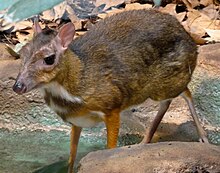Kleinkantschil
| Kleinkantschil | ||||||||||||
|---|---|---|---|---|---|---|---|---|---|---|---|---|

Kleinkantschil ( Tragulus kanchil ) in Munich's Hellabrunn Zoo |
||||||||||||
| Systematics | ||||||||||||
|
||||||||||||
| Scientific name | ||||||||||||
| Tragulus kanchil | ||||||||||||
| ( Raffles , 1821) |
The small kanchil ( Tragulus kanchil ) is a species of mammal from the family of the stag piglets (Tragulidae) and is, together with other representatives of the genus Tragulus , the smallest arthropod in the world. It is native to Southeast Asia .
description
Small squares reach a head body length of 45 to 55 centimeters, a shoulder height of 20 to 25 centimeters and a weight of 1.5 to 2.5 kilograms. The tail is only about 5 centimeters long.
Their fur is gray-brown on top, often with an orange tinge. The underside and chin are white. The head is pointed, the black nose is hairless and the eyes are very large. Their physique is round and rising towards the back, the legs look noticeably delicate in contrast to the body. Like all deer piglets, they have no antlers and no horns, but the upper canines, especially in males, are enlarged like tusks and protrude from the mouth.
distribution and habitat
The distribution area of the Kleinkantschils extends from southern China ( Yunnan ) to the Malay Peninsula and the islands of Sumatra and Borneo as well as smaller offshore islands. Its habitat consists of forests with dense undergrowth, mostly near water.
The Java Kantschil ( Tragulus javanicus ), which is endemic to Java , has been separated as a separate species.
Way of life
Kleinantschile are very shy, withdrawn animals that are mainly active at night. During the day they sleep in crevices or hollow tree trunks. At night they go in search of food, for which they create tunnel-like paths through the thicket.
There have been various observations of social behavior, both from animals that live solitary and from monogamous couples. They are distinctly territorial animals, with males having a range of around 12 hectares and females around 8.5 hectares. For communication, markings made of urine, feces and glandular secretions are used, which are ideally suited for the dense and light-poor jungle. Territorial fights between the males are fought with the long canine teeth.
food
Kleinantschile are primarily herbivores that eat leaves, buds and fruits. They also eat insects in zoos; It is not known to what extent these are also part of their diet in the wild.
Reproduction
The females often mate again a few hours after giving birth to their young and can thus spend most of their adult lives in pregnancy. After a gestation period of around 140 days, the female gives birth to two young animals, which are suckled on four teats. Young animals flee the nest and can walk 30 minutes after birth. After around 10 to 13 weeks they are weaned and sexually mature at around 5 to 6 months. The maximum age is 12 years.
Kleinkantschile and people
In Southeast Asian fairy tales , Kantschile are considered to be cunning animals, which have similar properties as in Central Europe to the red fox ( Reineke fox ). In many places the meat of these animals is eaten, they are also considered easy to tame and are sometimes made into pets. The main threat, however, is the ongoing clearing of the forests. The IUCN lists the species as low endangered.
literature
- Ronald M. Nowak: Walker's Mammals of the World . Johns Hopkins University Press, 1999 ISBN 0-8018-5789-9
Web links
- Tragulus kanchil inthe IUCN Red List of Threatened Species 2015.3. Listed by: Timmins, R. & Duckworth, JW, 2015. Retrieved January 30, 2016.
